Restoring Mountain Meadows Provides Water Supply and Habitat Benefits
|
Researchers Luke Hunt and Chuck Loffland are working to increase the understanding of how meadow restoration provides critical water supply and habitat benefits under climate change. The goal of this CA LCC-funded project is two-fold: 1) to increase the understanding of how meadow restoration impacts hydrology and 2) to inform management and investment decisions around using restoration as a tool to build resilience under climate change. |
|
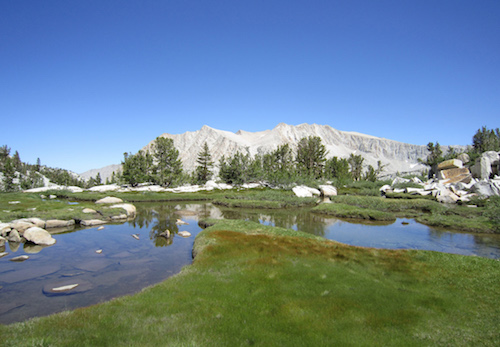 Above: A mountain meadow in its natural state slows and sinks water running off from Sierra snowpack. |
Learn about restoring mountain meadows: |
|
Mountain Meadows Play a Key Role in California's Future Water Supply This project scientifically proves that meadows are more than just pretty places; they are an important piece of our state's natural water system, acting like huge sponges that soak up spring snowmelt and release that precious water when it's most needed in the late summer, providing healthy flow conditions downstream even in a drought. In this project, meadow scientists measured the effect of restoration of a large meadow in Alpine County, which had been degraded by historic land use practices, on downstream summer flows. Following restoration, the meadow added between 3 and 8 times more water during the June-October low-flow season than before restoration, even while California was experiencing a severe drought! This work helps resource managers make a strong case for meadow restoration as an important climate adaptation tool. You can find this data presented in this Fact Sheet, and in Luke Hunt's Webinar describing the project in more detail. |
|
|
The Benefits of Meadow Restoration Drought and Climate Change resilience Habitat improvement Improved forage Recreation |
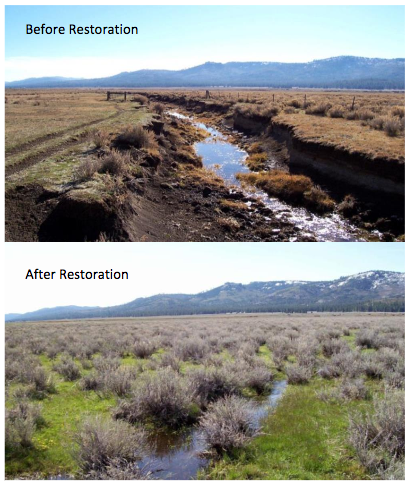 |
Making Meadow Restoration Happen
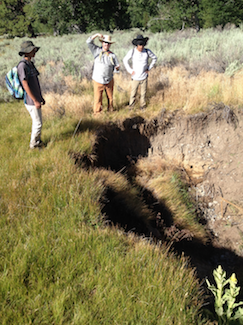 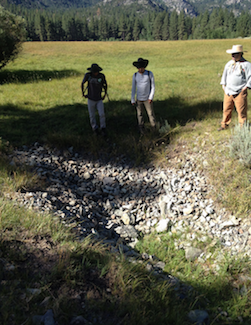 Above: Stakeholders survey a head-cut caused by erosion damage (left), and a repaired head-cut (right) as part of the assessment of a Pleasant Valley Meadow in the Carson River Watershed. |
|
|
Prioritizing Meadows and Finding the Funding Now that we're convinced of the value of restoring meadows, the next step is to get to work and do it. To prioritize meadows for restoration, the project scientists assessed hundreds of meadows across the Sierra Nevada for their ecological attributes, the first part of the equation of restoration potential. This data are available from the Sierra Nevada Meadows Data Clearinghouse website. Next, the scientists, stakeholder groups such as American Rivers, and the local landowners went through the list to pick good candidates, conducting site visits and assessing which meadows were most ready and would provide the most benefits when restored. They then developed plans and sought the funding to do the work, successfully raising the money for restoring priority meadows in eight Sierra Nevada watersheds: Walker, Truckee, Carson, American, Eagle Lake, Kern, Sequoia, and Tuolumne. Work is also underway in the Modoc Plateau. |
|
|
Consolidating the Effort for State-wide Benefits While some work has been done in the past by individual organizations to restore meadows, this approach has the effect of unifying the effort across organizations and across the region, making it possible to invest in the larger goal of improved water security for the entire state. To date, this cooperative effort has leveraged over a million dollars in restoration funding, coming from Proposition 1 (water bond) investments that were the result of meadow restoration being called out in the California Water Plan, as well the Department of Fish and Wildlife's cap and trade (greenhouse gas mitigation) funds and other sources. |
|
|
Providing Training in Meadow Restoration Another important piece of the puzzle is training more people to do the restoration work. In 2016 the program offered meadow restoration training for twenty U.S. Forest Service practitioners, including hydrologists from across the state. During the one-week training, participants designed a meadow restoration project from start to finish under instruction from the Plumas Corporation, Forest Service, and others. The training also included modules on watershed assessment and prioritization, building support from within the agency, environmental permitting, partnering, fundraising, contracting, budgeting, and monitoring. The goal is to encourage and enable federal land managers to undertake meadow restoration projects and build the team necessary to do so. Follow-up is occurring through a mentoring program. Publishing the Science A publication explaining the results of the Indian Valley study, and an estimate of the aggregate flow benefits from meadow restoration across the Sierra Nevada, has been submitted to the Journal of the American Water Resources Association and is expected to be published later this year. |
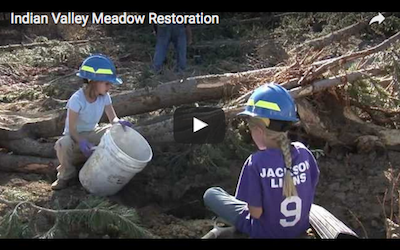 Learn about how this work is being piloted in this video: Indian Valley Meadow Restoration |
Further reading:
For more resources, please see this Annotated Bibliography and this subject search on the Climate Commons.
You can find the products of this project on the Climate Commons.
See also this article by the Water Deeply newsletter: Work Grows to Restore Mountain Meadows as Water Banks
The California Landscape Conservation Cooperative, the National Fish and Wildlife Foundation, Coca-Cola, and the Bella Vista Foundation provided funding for this work. Key partners include the Plumas Corporation, Alpine Watershed Group, Institute for Bird Populations, and Amador-Calaveras Consensus Group and US Forest Service.
7/2017
